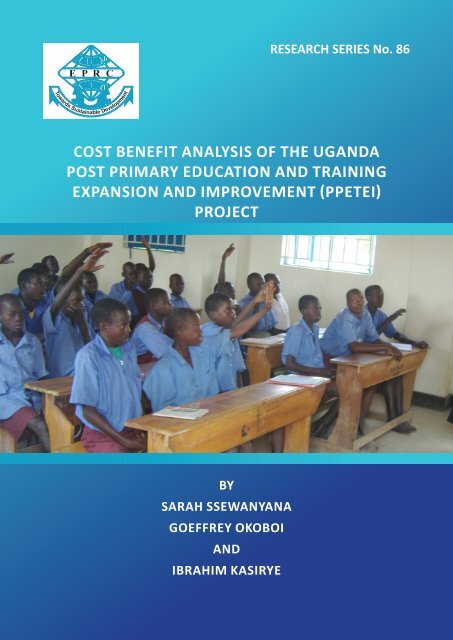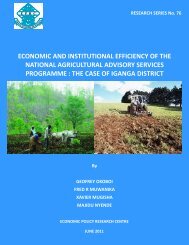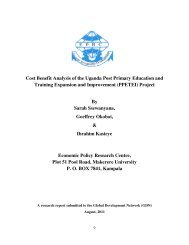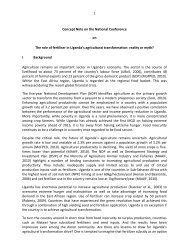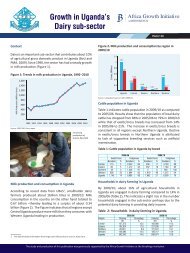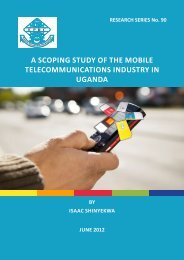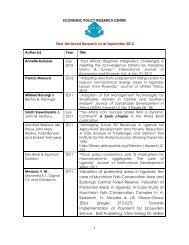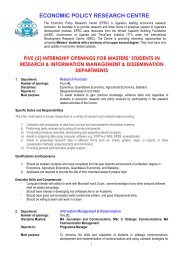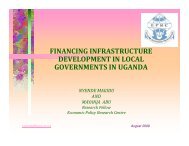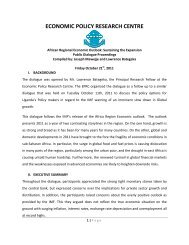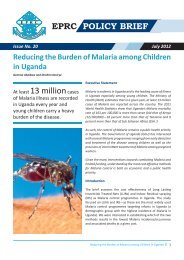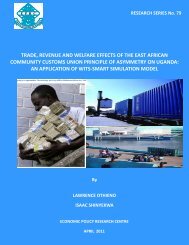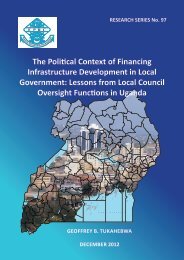CoSt BENEfIt ANAlySIS of tHE UgANdA PoSt PRImARy EdUCAtIoN ...
CoSt BENEfIt ANAlySIS of tHE UgANdA PoSt PRImARy EdUCAtIoN ...
CoSt BENEfIt ANAlySIS of tHE UgANdA PoSt PRImARy EdUCAtIoN ...
Create successful ePaper yourself
Turn your PDF publications into a flip-book with our unique Google optimized e-Paper software.
RESEARCH SERIES No. 86Cost Benefit Analysis <strong>of</strong> the Uganda PostPrimary Education and Training Expansionand Improvement (Ppetei) ProjectBySarah Ssewanyana,Goeffrey Okoboi,andIbrahim Kasirye
Cost Benefit Analysis <strong>of</strong> the Uganda Post Primary Education and Training Expansion and Improvement (Ppetei) Project1. IntroductionExpanding access to schooling in developing countries is critical for achieving poverty reductionand sustained economic growth. Although countries in sub-Saharan Africa (SSA) have expandedaccess to primary schooling in the past 15 years, absorbing primary school graduates intosecondary school remains a challenge. As a result <strong>of</strong> implementing UPE programmes, thenumber <strong>of</strong> children out <strong>of</strong> primary school in SSA has declined—from 45 million in 1999 to32 million by 2007 (UNESCO 2010). However, despite the surge in primary school enrolmentas a result <strong>of</strong> universal primary education (UPE), the transition from primary to secondaryschooling remains low in developing countries. Indeed, the 2010 Education For All GlobalMonitoring Report shows that 38 percent <strong>of</strong> children in SSA who are supposed to be in lowersecondary school are out <strong>of</strong> school compared to 26 percent <strong>of</strong> children out <strong>of</strong> primary school(UNESCO 2010). Furthermore, unlike the case for UPE where enrolment gaps between thepoorest and richest pupils have significantly declined, access to secondary education remainsinequitable—to the detriment <strong>of</strong> poor children. As such, a number <strong>of</strong> countries in SSA haveintensified efforts to expand access to secondary schooling through a replication <strong>of</strong> UPE typeinterventions.Prior to 2007, Uganda was among the SSA that had failed to increase the transition <strong>of</strong> pupilsto secondary school during the implementation <strong>of</strong> UPE. During the 2003-2006period, only 50percent <strong>of</strong> pupils who passed primary leaving examinations (PLE) joined secondary schooling.Worse still, the majority who enrolled in lower secondary schools, dropped out before the age<strong>of</strong> 18 years. For instance, only 18 percent <strong>of</strong> children aged 13-19 years in Uganda were actuallyin secondary schools in 2005/06 (Uganda Bureau <strong>of</strong> Statistics (UBoS), 2007). 1 Furthermore,among those in school, the poor and females areunder-representated. As part <strong>of</strong> the widerimplementation <strong>of</strong> the Poverty Eradication Action Plan (PEAP) (2005-2010), the Government<strong>of</strong> Uganda (GoU) introduced the Universal Post Primary Education (UPPE) in 2007. Specifically,the government decided to provide free tuition to secondary school pupils starting with300,000 primary school graduates in 2007. Similar to the UPE arrangement, the governmentprovided tuition while parents were expected to provide exercise books, uniforms, meals, andother scholastic materials. In financial terms, under the initiative, the GoU spends Ushs 45,000(about US$25) per student per year and this translates to Ushs 100 billion or US$56.3 millionper year. Combined with the free tuition, the government also made efforts to expand accessto secondary education by ensuring that every sub county in Uganda has a secondary school.In 2008, at least 271 sub-counties did not have either a public or private secondary school.1This very low net secondary enrolment may be partly explained by both late enrolment into primary school as a consequence delayedtransition and high grade repetition rates in secondary school. In 2005/06, the primary gross enrolment rate was 115 was the net enrolmentrate was 85 (UBoS, 2007) and this is explained by delayed enrolment into primary school. On the other hand, the annual educationstatistical abstract shows that at least 11 percent <strong>of</strong> primary school pupils are repeating grades with repetition rates highest in the firstgrade—at 12.4 percent (Ministry <strong>of</strong> Education and Sports, 2008).Economic Policy Research Centre - EPRC1
Cost Benefit Analysis <strong>of</strong> the Uganda Post Primary Education and Training Expansion and Improvement (Ppetei) Project2. Background and contextWith an annual Gross Domestic Product (GDP) per capita <strong>of</strong> US$ 480 (World Bank 2010),Uganda remains one <strong>of</strong> the poorest countries in SSA. Indeed, the 2010 Human DevelopmentReport (HDR) ranks Uganda 143 out <strong>of</strong> 169 countries based on the Human Development Index(UNDP 2010). Furthermore, due to the predominance <strong>of</strong> informal activities and weak taxadministration system, the country collects only about 13.7 percent <strong>of</strong> its GDP in taxes (GoU2010). As such the amount <strong>of</strong> funds available for financing education interventions as wellas other social services are limited. There is competition for overall public budget across andwithin sectors. In addition, poverty remains the most pressing challenge faced by the countrydespite the recent improvements in household welfare status.Despite the very low average incomes, Uganda has made tremendous progress in reducingthe incidence <strong>of</strong> poverty—as captured by household expenditures. Table 1 shows the trendsin income poverty during 1992/3 and 2009/10 and it is indicated the incidence <strong>of</strong> incomepoverty reduced from 55 percent in 1992/93 to 24 percent by 2009/10. The most recenttrends have been driven by the dramatic reduction in poverty in Northern Uganda after thecessation <strong>of</strong> armed hostilities between the Lord’s Resistance Army (LRA) and the Ugandanarmy (UBoS 2010). Previous changes were mainly driven the favourable prices <strong>of</strong> majorexportssuch as c<strong>of</strong>fee (Deininger and Okidi 2003; Kappelet al. 2005). Furthermore, althoughthe poverty headcount index reduced from 56 percent in 1992/93 to 24 percent by 2009/10;the actual population <strong>of</strong> the poor only reduced from 9.9 million to 8.9 million during the sameperiod—partly due to the very high population growth rates <strong>of</strong> 3.2 percent per annum (UBoS2002).Overall the incidence and distribution <strong>of</strong> poverty depicted in Table 1 has implications forhousehold’s ability to finance schooling—even in an era <strong>of</strong> free public schooling. In particular,due to poverty, households in some parts <strong>of</strong> country are unable to meet the additionalexpenditures demanded under free public education e.g. meals and uniforms.Economic Policy Research Centre - EPRC3
Cost Benefit Analysis <strong>of</strong> the Uganda Post Primary Education and Training Expansion and Improvement (Ppetei) ProjectTable 1: Trends in poverty head count, 1992-2010 (%)1992/93 1999/00 2002/3 2005/6 2009/10All Uganda 54.9 33.4 38.8 31.1 24.5Rural 58.5 37.4 42.7 34.2 27.2Urban 27 9.6 14.3 13.7 9.1RegionsCentral 45.6 19.3 22.5 16.4 10.7Eastern 58.8 34.2 45.9 35.9 24.3Northern 72.2 63.4 62.9 60.7 46.2Western 53.1 25.9 32.9 20.5 21.8Notes: The 1999/2000 figures excludes the districts <strong>of</strong> then Bundibugyo, Gulu, Kitgum, Kasese, Pader.Source: UBOS UNHS Reports 2000, 2002, and 2006. The figures for 1992/93 are author’s calculation based on the IHS 1992During the implementation <strong>of</strong> UPE and USE programmes, the Government <strong>of</strong> Uganda hasdevoted substantial resources to the education sector. Between 1991 and 2004, the share <strong>of</strong>the education sector in the total budget increased from 20 percent to 30 percent (Ministry<strong>of</strong> Education and Sports (MoES) 2004). For the financial year 2011/12 the government hasallocated about Ushs1,393 billion (US$535 million) to education programmes (Ministry <strong>of</strong>Finance Planning and Economic Development (MoFPED) 2011). However, this only representsabout 15 percent <strong>of</strong> the national budget—due to increased focus in the national budget onenergy and road construction—whose shares have doubled since 2003/04 financial year toabout 15% <strong>of</strong> the national budget. As a consequence, within the education sector in Uganda,different sub sectors continue to compete for the scarce resources. Figure 1 shows theshares <strong>of</strong> the primary and secondary sub sectors in the overall education budget during thefinancial years 2001/2-2010/11 and the projected allocations during the 2011/12-2014/15period. It is indicated that the share <strong>of</strong> education resources accruing to the primary sub sectorhas gradually declined—from 69 percent in 2001/2 to 65 percent by 2010/11. On the otherhand, the secondary sub sector has overtime gained prominence within the overall educationbudget—increasing from 14 percent in 2001/2 to 21 percent by the financial year 2010/11.Nonetheless, both the primary and secondary sub sectors are projected to register reductionsin their respective share in 2014/15—due to a projected shift in focus on university/tertiaryeducation in 2014/15.4Economic Policy Research Centre - EPRC
Cost Benefit Analysis <strong>of</strong> the Uganda Post Primary Education and Training Expansion and Improvement (Ppetei) ProjectFigure 1: Share <strong>of</strong> the primary and secondary education subsector in the education budget(%)Source: Background to the Budget (various issues): MoFPEDAlthough post primary education has received increased funding in the recent past, theprogramme is nonetheless plagued by a number <strong>of</strong> challenges. First, unlike the case <strong>of</strong>primary schools, the government does not own most <strong>of</strong> the secondary schools where theUPE graduates are supposed to enrol. The government only owns 31 percent <strong>of</strong> the availablesecondary schools compared to 74 percent <strong>of</strong> the primary schools (MoES 2008). Secondly, thetransition <strong>of</strong> girls to secondary schools remains a problem—only 33 percent <strong>of</strong> girls who enrolinto primary school remain in school up to the age <strong>of</strong> 18 years compared to 50 percent forboys (GoU 2010). Third, just as is the case in primary schools, secondary schools are congestedplaces with a student to classroom ratio <strong>of</strong> 1:60 compared to the desired <strong>of</strong> 1:35 (GoU 2010).Finally, unlike UPE, where all public primary schools are free and all pupils are eligible to enrolat the nearest public school, a different system operates for secondary education. Specifically,enrol into a secondary school is based on performance at the primary leaving examination(PLE) and most elite public secondary school charge fees similar to those in private secondaryschools. 2Even after the introduction <strong>of</strong> the UPPE programme in 2007 and concomitant increase in thesecondary school population by 25 percent, the structure <strong>of</strong> the secondary school populationhas not changed that much. Figure 2 shows both the net and gross secondary school enrolmentrates for children aged 13-18 years based on the nationally representative household surveys.It is indicated that the NER for boys increased by only 3 percentage points (from 22 percent in2005/06 to 25 percent by 2009/10) while that <strong>of</strong> girls remained the same. A similar situation isobserved for the gross enrolment rates i.e. there are minimal changes after the introduction <strong>of</strong>2 The government allowed this two-tier system so that the quality <strong>of</strong> public secondary schooling does not reduce as was the case when UPEwas introduced in primary schools.Economic Policy Research Centre - EPRC5
Cost Benefit Analysis <strong>of</strong> the Uganda Post Primary Education and Training Expansion and Improvement (Ppetei) ProjectUPPE. The same figure also highlights a widening gender gap in secondary school enrolments.Overall, Figure 2 shows that secondary school enrolments remain very low. Furthermore,policy makers in the Ministry <strong>of</strong> Education are <strong>of</strong> the view that increments in secondary schoolattainment will be much slower than what was observed under UPE (MoES 2011). The currentNational Development Plan projects that net secondary school enrolments will only increaseby 10 percentage points to 35percent—between 2010/11-2014/15 (GoU 2010). The modestprojections are partly driven by the lack <strong>of</strong> public secondary schools to absorb all the UPEgraduates and as such any surge in secondary school population can only be accommodatedby the fee paying private schools.Figure 2: Net and gross enrolments in secondary schools, 1992/93-2009/10 (%)1992/93GirlsBoys1992/93Girls1999/20001999/2000Net Enrollment2002/03Gross Enrolment2002/032005/062005/062009/102009/100 10 20 300 10 20 30 40Source: Author’s calculations from the 1992/93 HIS; 1999/2000 UNHS; 2002/3 UNHS and 2009/10 UNHS.6Economic Policy Research Centre - EPRC
Cost Benefit Analysis <strong>of</strong> the Uganda Post Primary Education and Training Expansion and Improvement (Ppetei) Project3. Uganda Post Primary Education and Training Expansion andImprovement (PPETEI) ProjectAs part <strong>of</strong> the multilateral donors supporting the education sector in Uganda, the AfDB in2008 <strong>of</strong>fered a US$ 85 million loan to the GoU (AfDB 2008). The loan was to support the USEas well as the Universal Post Primary Education and Training interventions. The bank throughthe PPETEI project sought to increase the number <strong>of</strong> available secondary school places by100,000 between 2008 and 2013. The projects intended to provide infrastructure, equipment,textbooks and also support teacher training. In particular, the target was to construct andequip 71 secondary schools as well as train 2,500 teachers. The overall project objectiveswere: to increase the transition rate from primary to secondary education from 68 percentto 80 percent; increase the proportion <strong>of</strong> girls in secondary school—from 46 percent to 50percent; increase the net enrolment rate from 18 percent to 30 percent; reduce the number <strong>of</strong>sub-counties in Uganda without secondary schools from 271 to less than 100. 3 It is anticipatedthat through the equipping and construction <strong>of</strong> new secondary schools, at least 20,000 newsecondary school places will be created for the normal shift as well as 40,000 new placesunder the double-shift program. It is also envisioned that the ratio <strong>of</strong> text books per studentwill improve from 1:4 to 1:3.One <strong>of</strong> the major justifications for the support by AfDB was the fact there were large welfareand gender gaps in secondary school enrolment in Uganda. Table 2 shows the trends in the netand gross secondary school enrolments for children aged 13-16 years by welfare status andgender—in 2005/6 and 2009/10. First, it is indicated that both net and gross enrolment showwide welfare gaps. Specifically, the net enrolment rates <strong>of</strong> children from the richest quintileare more than five times the rates for poorest quintile. It is also worth noting that althoughthe net enrolment rates appear to favour girls over boys among the top two quintiles—thegross enrolment rates only favour boys. The latter result suggests that boys are likely to stay insecondary school longer than girls. Second, if one can use the two survey periods to gauge theshort term impacts <strong>of</strong> the UPPET programme, Table 2 shows that the initiative has so far hadbeen most beneficial to male children—increasing their GER for both the richest and poorestquintiles. For other income and demographic groups, the enrolment pr<strong>of</strong>iles have remainedmore or less unchanged. 4 In the next section, we examine the cost benefit analysis <strong>of</strong> theoverall PPETEI project—in relation to the anticipated costs.3 In 2008, the GoU owned 911 secondary schools and at least 237 sub counties did not have a public secondary school. At least 83 percent <strong>of</strong>the sub counties without a public secondary school had a private secondary school. The UPPET program intends to establish new schoolsin the 38 sub counties without a public or private secondary school.4 The NER and GER quoted in Table 2 differ from earlier stated rates due to differences in the age <strong>of</strong> children considered. This table considersonly children aged 13-16 years.Economic Policy Research Centre - EPRC7
Cost Benefit Analysis <strong>of</strong> the Uganda Post Primary Education and Training Expansion and Improvement (Ppetei) ProjectTable 2: Trends in net and gross secondary enrolment rates by gender and expenditurequintile, 2005/6-2009/10 (%)2005/06 2009/10All Girls Boys All Girls BoysNet Enrolment Rates (NERs)QuintilesQ1 3.8 5.3 2.2 5.5 3.5 7.4Q2 6.9 8.4 5.5 10.1 11.6 8.8Q3 12.3 16.3 8.6 15.5 14.9 16.1Q4 16.6 19.5 13.3 19.6 21.8 17.4Q5 37.9 37.4 38.7 37.9 40.3 34.8All children 13-16 years 15.5 17.5 13.5 18.7 19.8 17.8Gross Enrolment Rates (GER)QuintilesQ1 11 11.5 11 16.5 9.4 23.1Q2 27.4 23.6 31.1 27 23.4 30.4Q3 40.6 39.6 41.6 40.6 36.8 44.1Q4 51.2 51.7 50.7 56.5 51.8 61.1Q5 100.2 85.9 118.2 93.5 84.3 105.5All children 13-16 years 46.2 42.7 50.7 49.2 44.1 55.7Source: Author’s calculations from the 2005/6 and 2009/10 UNHS8Economic Policy Research Centre - EPRC
Cost Benefit Analysis <strong>of</strong> the Uganda Post Primary Education and Training Expansion and Improvement (Ppetei) Project4. Economic analysis <strong>of</strong> the PPEPI projectIn this section, we provide the economic analysis <strong>of</strong> the PPPEP project—based on the projectcosts and part <strong>of</strong> the anticipated benefits. In particular, we undertake a cost benefit analysisrelating to increased enrolment and completion <strong>of</strong> secondary school and we also conduct asensitivity analysis <strong>of</strong> the assumptions we make. Similar economic analysis has been conductedfor other developing countries e.g. Costa Rica (World Bank 2005)—for the Equity and Efficiency<strong>of</strong> Education Project. The project costs for the PPETEI are distributed over the 5 years basedon the disbursement schedule outlined in the AfDB’s project appraisal report.As earlier mentioned they are various anticipated benefits <strong>of</strong> the PPETEI projects—rangingfrom increased secondary school enrolment by 100,000 to attaining gender parity in secondaryschooling, to elimination <strong>of</strong> sub counties without secondary schools. However, in the economicanalysis, we focus on only one benefit—increase in secondary school enrolment—due to datalimitations. In particular, we quantify the increased earnings <strong>of</strong> the secondary school studentsover students who do not enrol in secondary school—for the students who join secondaryschool as a result <strong>of</strong> the available 60,000 new school places. Based on estimates by Ssewanyanaand Kasirye (2010), secondary school graduates in Uganda earn on average annually earnUS$ 630 more than primary school graduates. We use the Net Present Value (NPV) and theInternal Rate <strong>of</strong> Return (IRR) as the basis for CBA estimates. The other benefits <strong>of</strong> the projectnot considered in the analysis are presented in Table 3.Table 3: Project beneficiaries and targetsBenefit Baseline Expected changeIncrease in transition rate from primary 68% Plus 12% points in 5 yearsto secondaryIncrease in the proportion <strong>of</strong> girls in 46% Plus 4% points in 5 yearssecondary schoolIncrease in GERs in secondary school 25% Plus 10% points in 5 yearsIncrease in NERs in secondary school 21.30% Plus 9% points in 5 yearsIncrease in number <strong>of</strong> places in 71institutions60,000 20,000 new places created undernormal system and 40,000 new placesunder the double shift systemIncrease ratio <strong>of</strong> textbooks per student 1:4 1:3Source: African Development Bank (2008)The overall project benefits can be outlined as follows. First, in the absence <strong>of</strong> the project,a total <strong>of</strong> 100,000 students would miss secondary education. The estimated annual future(post secondary) earnings lost from this group are US$ 30 million. Second, given that at least500,000 pupils sat for PLE in 2008 and estimated 340,000 managed to enrol into secondaryschool, by 2014, it is expected that at least 400,000 (80 percent <strong>of</strong> 600,000 pupils sittingEconomic Policy Research Centre - EPRC9
Cost Benefit Analysis <strong>of</strong> the Uganda Post Primary Education and Training Expansion and Improvement (Ppetei) ProjectPLE) will be joining secondary school. Third, it is also expected that the population <strong>of</strong> girlsenrolling in secondary school will increase from 156,000 in 2008 to 240,000 (50 percent <strong>of</strong> theenrolling population) by 2014. Finally, it is expected that the net enrolment ratio will increasefrom 21.3 percent in 2008 to 30 percent by 2014. Specifically, the estimated population <strong>of</strong>children aged 13-16 years who are actually in secondary school would increase from 703,000to 1,120,000. 5We also assume that students who enrol in secondary school stay and complete the full 6 yearcycle. As such, we do assume no dropouts and grade repetition. To some extent, this appearsas a very strong assumption given the context <strong>of</strong> very high dropout rates experienced in theUganda school system. Indeed, the data from the education abstracts reveal that about half<strong>of</strong> the students drop out after the fourth grade <strong>of</strong> secondary schooling—the Ordinary level(MoES 2008). Given that the main reasons students drop out after O-level is due to inadequatefinances, we retain this particular assumption since one <strong>of</strong> the objectives <strong>of</strong> the intervention isto reduce the financial burden faced by parents.On the other hand, the benefits <strong>of</strong> the projects start accruing after 6 years although the projectsupport is for 5 years. In addition, we assume a time horizon <strong>of</strong> 12 years—to take account <strong>of</strong>at least 6 years <strong>of</strong> post secondary school earnings. Finally, we assume that all the studentswho benefit from the project find wage employment and their earnings are constant in dollarterms over the next 6 years. The costs <strong>of</strong> the project and the basis for calculating the benefitsare provided in Table 4.5 This figure assumes that the annual population growth rate remains 3.2 percent per annum (UBoS 2002).10Economic Policy Research Centre - EPRC
Cost Benefit Analysis <strong>of</strong> the Uganda Post Primary Education and Training Expansion and Improvement (Ppetei) ProjectTable 4: Unit costs and cost <strong>of</strong> interventionsCost <strong>of</strong> Project US$ 93.6 million (Africa Development Bank: US$ 84;Government <strong>of</strong> Uganda: US$ 9.6 million during the projectlife. Constituent costs (i) improvement and expansion <strong>of</strong>school facilities: US$ 86 million. (ii) improvement in schoolmanagement and teaching quality: US$ 5.6 million. (iii)project management: US$2.2 million)Unit Cost <strong>of</strong> a student insecondary school US$ 240Average incremental earnings <strong>of</strong>primary school graduates overnon-graduates US$630 (Estimates by Ssewanyana and Kasirye 2010)Unitary cost <strong>of</strong> educationDemand subsidies in secondaryeducationOther parametersDiscount rate 10%Projections <strong>of</strong> enrolled students 60,000Time horizon12 yearsSchool fees; US$ 186 per student/yearTransportation: US$ 11Uniforms and sports kits: US$ 11.3Books and scholastic materials: US$ 23.6Other school expenditures: US$23 (Estimated bySsewanyana and Kasirye 2010)Source: African Development Bank (2008)Other assumptions made relate with the costs <strong>of</strong> getting children through school and associatedmaintenance <strong>of</strong> established facilities. We assume that maintenance costs are incurred fromthe second year <strong>of</strong> the project and for the first 5 years, these costs are 8 percent <strong>of</strong> theaccrued investment costs. After 5 years, the maintenance costs increase due to wear andtear and we assume a higher maintenance ratio <strong>of</strong> 15 percent. Furthermore, we assume thatthe GoU will be fully responsible for the maintenance costs and these will be met from anincreasing allocation to the education sector recurrent budget over the project lifetime.Table 5 provides the summary <strong>of</strong> the cost benefit analysis undertaken. Based on the discountrate <strong>of</strong> 10 percent, we estimate that the project’s benefit cost ratio is 3.2. The project wouldyield a net present value after investments <strong>of</strong> US$120 million over the 12 year period andproduce an internal rate <strong>of</strong> return <strong>of</strong> 25 percent. The relatively high benefit cost ratio may bepartly explained by the currently very large difference in earnings between secondary schoolgraduates and those who dropout after the completion <strong>of</strong> primary school. It is expected thatas the population <strong>of</strong> the secondary school graduates increases and that <strong>of</strong> primary schoolgraduates who dropout decreases, the gap in earnings will decline. 66Due to data limitations, we do incorporate this possibility in our estimations.Economic Policy Research Centre - EPRC11
Cost Benefit Analysis <strong>of</strong> the Uganda Post Primary Education and Training Expansion and Improvement (Ppetei) ProjectTable 5: Summary <strong>of</strong> cost benefit analysis, US$ millionsTotal Investment andPresent valueYear operation costs Total Benefits NPV2009 2.81 0 -2.552010 21.75 0 -17.982011 35.64 0 -26.782012 31.79 0 -21.712013 15.24 0 -9.462014 7.488 0 0.002015 14.04 30 8.192016 14.04 60 21.442017 14.04 90 32.212018 14.04 120 40.852019 14.04 150 47.652020 14.04 180 52.88Total 199 630 124.75BC 3.2IRR 25%NPV $120.52As earlier mentioned we assess to what extent some changes in the stated assumptions affectsthe expected benefits <strong>of</strong> the projects through a sensitivity analysis exercise. In particular, wefocus on: (i) if the expected benefits <strong>of</strong> the projects are reduced e.g. arising from changes ineconomic conditions; and (ii) delays in the project implementation e.g. because the Ministry <strong>of</strong>Education and Sports takes considerably more time to acquire the land to construct the newsecondary schools. In the first case, we consider the alternatives <strong>of</strong>: 10 percent reduction inbenefits; 20 percent reduction in benefits; and 30 percent reduction in benefits. For the secondcase, we consider the following alternatives: 1 year delay in the project implementation; a 2years delay in the project implementation; and 3 years delay in the project implementation.The summary results for the above two scenarios are presented in Table 6. In all the scenariosconsidered, the project would remain sustainable.12Economic Policy Research Centre - EPRC
Cost Benefit Analysis <strong>of</strong> the Uganda Post Primary Education and Training Expansion and Improvement (Ppetei) ProjectTable 6: Summary <strong>of</strong> sensitivity analysisScenario <strong>of</strong> reduction in benefitsBase 10% 20% 30%Total Benefit (US$ millions) 630 567 504 441Benefit Cost ratio 3.2 2.8 2.5 2.2Internal Rate <strong>of</strong> Return 25% 23 21 18Scenario <strong>of</strong> delays in implementation <strong>of</strong>the projectBase 1 year 2 years 3yearsTotal Benefit (US$ millions) 630 450 300 180Benefit Cost ratio 3.2 2.4 1.8 1.1Internal Rate <strong>of</strong> Return 25% 21% 14% 4%However, the above results should be interpreted in the Ugandan context characterized bydemand side challenges—notably high school dropout rates and low school attendance. Forinstance, out <strong>of</strong> the 179,000 students enrolling in secondary school in 2003, only 40 percentmanaged to reach the last grade <strong>of</strong> secondary school by 2008 (MoES, 2008). The largestdropout is registered after four years <strong>of</strong> secondary schooling, where more than half <strong>of</strong> thestudents who attended the Senior Four do not proceed to Senior Five after sitting for theUganda Certificate <strong>of</strong> Education exams. Consequently, the results <strong>of</strong> our sensitivity analysisshould be interpreted in the context <strong>of</strong> significant potential dropout after four years—due toeither inadequate school fees or poor performance innational exams.Economic Policy Research Centre - EPRC13
Cost Benefit Analysis <strong>of</strong> the Uganda Post Primary Education and Training Expansion and Improvement (Ppetei) Project5. Potential evaluation <strong>of</strong> the projectA number <strong>of</strong> methods can be used to evaluate whether the project has attained its intendedobjectives. First, with regards to increase in the transition from primary to secondary school,the Ministry <strong>of</strong> Education and Sports undertakes an annual headcount and the results arepublished in the Education Statistical Abstract. Analysis <strong>of</strong> this information after 5 years <strong>of</strong>project implementation could provide evidence <strong>of</strong> an increases in the proportion <strong>of</strong> studentsenrolling in secondary school. Secondly, as a complement to the <strong>of</strong>ficial education statistics, wewould propose an impact evaluation survey in the communities benefiting from the project. Inparticular, we would undertake a sample surveys in at least 50 communities (25 communitieshaving schools that have benefited from the project and another 25 communities as controls).Within the selected communities, we would undertake a detailed household sample survey—whose major objective would be to collect information on schooling <strong>of</strong> children. In additionto the household survey, we would undertake unannounced visits to the schools to captureinformation on school enrolment and attendance. Standard econometric techniques wouldbe used to gauge: (1) whether the project has improved overall transitions from primary tosecondary; (2) whether the proportion <strong>of</strong> girls has improved as result <strong>of</strong> the project; and (3)whether benefiting schools on average have higher scholastic materials such as textbookscompared to schools that did not benefit from the project.14Economic Policy Research Centre - EPRC
Cost Benefit Analysis <strong>of</strong> the Uganda Post Primary Education and Training Expansion and Improvement (Ppetei) Project6. Conclusions and policy implicationsThis paper examines the cost effectiveness and benefit cost analysis <strong>of</strong> the Uganda PostPrimary Education and Training Expansion and Improvement project supported by the AfricaDevelopment Bank during the 2008-2014 period. The project seeks to change the secondaryschool enrolment pr<strong>of</strong>ile in Uganda by expanding the number <strong>of</strong> public secondary school placesavailable as well as introduce a double shift system in some secondary schools—to expandaccess to secondary schooling. We face a major limitation in the analysis as we do not haveany outcome measure. Nonetheless, we hypothesize that the benefits <strong>of</strong> the project can berepresented by the expected earnings. Based on the expected post secondary school earningsas our only benefit considered—the project is very sustainable. Our sensitivity analysis alsoreveals that the projects remains sustainable even if the expected benefits are reduced by upto 30 percent or even if the project implementation is delayed by up to 3 years. Furthermore,the intervention has equity implications—favouring poor girls based on the net enrolmentrate indicators whereas in the long term boys benefit more due to staying in secondary schoollonger.Secondly, based on the gaps in secondary school attainment, the project is going to make only asmall change in the secondary school enrolment pr<strong>of</strong>ile for Uganda. Majority <strong>of</strong> UPE graduatesjoin fee paying private schools. The fact that the government does not have enough secondaryschools to take up the UPE graduates suggests serious resource constraints in the educationsector. It is possible that the GoU may require to spend an additional US$90 million annually—in order to change the secondary school pr<strong>of</strong>ile <strong>of</strong> the country. The government should useinternal resources to expand such required secondary school space. As demonstrated since2007 when the GoU intensified efforts to expand the country’s infrastructure, substantialinternal resources can be raised to address the current shortcomings in Uganda’s secondaryschool system.Economic Policy Research Centre - EPRC15
7. ReferencesCost Benefit Analysis <strong>of</strong> the Uganda Post Primary Education and Training Expansion and Improvement (Ppetei) ProjectAfrican Development Bank (2008),Uganda Post Primary Education and Training Expansion andImprovement Project (Education IV Project): Project Appraisal Report.Deininger, K. and J. Okidi (2003) “Growth and Poverty Reduction in Uganda, 1992-1999: PanelData Evidence”,Development Policy Review, (21): 481-509.Government <strong>of</strong> Uganda (2010) National Development Plan 2010/11-2014/15 (Kampala:National Planning Authority).Kappel, R. T., S. Steiner and J. Lay (2005), “Uganda: No more Pro-poor Growth?”, DevelopmentPolicy Review, 23(1): 27-53.Ministry <strong>of</strong> Education and Sports (2008), Education Statistical Abstract 2008(Kampala: Ministry<strong>of</strong> Education and Sports).Ministry <strong>of</strong> Finance, Planning and Economic Development (2011), The Background to theBudget 2011/2012 Fiscal Year: Promoting Economic Growth, Job Creation and ImprovingService Delivery (Kampala: Ministry <strong>of</strong> Finance, Planning and EconomicDevelopment).Ssewanyana, S and I. Kasirye (2010),“Gender differences in Uganda: The case for access toeducation and health services”, EPRC Research Series #68.Uganda Bureau <strong>of</strong> Statistics (2010),2009/10 Uganda National Household Survey: Socio-economic report (Kampala: Uganda Bureau <strong>of</strong> Statistics).______, (2007),2005/6 Uganda National Household Survey: Socio-economic report (Kampala:Uganda Bureau <strong>of</strong> Statistics).________, (2003) Uganda National Household Survey 2002-2003: Social Economic Report(Entebbe: UBoS).________, (2002) Uganda Population and Housing Census 2002 (Kampala: Uganda Bureau <strong>of</strong>Statistics).________, (1999) Uganda National Household Survey 1999-2000: Social Economic Report(Entebbe: UBoS).________, (1993) Integrated Household Budget Survey 1992-1993 (Entebbe: StatisticsDepartment).United Nations Development Program (2010), Human Development Report 2010: The RealWealth on Nations: Pathways to Human Development (New York: United Nations).UNESCO (2010), EFA Global Monitoring Report 2010: Reaching the marginalized (Oxford:UNESCO and Oxford University Press).World Bank (2010), World Development Indicator database for 2009 (Washington, DC: TheWorld Bank)._______, (2005) Project Appraisal Document on a Proposed Loan in the Amount <strong>of</strong> US$30Million to the Republic <strong>of</strong> Costa Rica for the Equity and Efficiency <strong>of</strong> Education Project.16Economic Policy Research Centre - EPRC
Cost Benefit Analysis <strong>of</strong> the Uganda Post Primary Education and Training Expansion and Improvement (Ppetei) Project8. EPRC RESEARCH SERIESListing <strong>of</strong> EPRC Research Series published since 2005 to date. Full text format <strong>of</strong> these andearlier papers can be downloaded from the EPRC website at www.eprc.or.ugNo Author(s) Title Year /Status85 Barungi Mildred& KasiryeI brahim84 Kasirye Ibrahim &Ahaibwe GemmaCost-Effectiveness Of Water Interventions: TheCase For Public Stand-Posts And Bore-Holes InReducing Diarrhoea Among Urban HouseholdsIn UgandaCost Effectiveness Of Malaria ControlProgrammes In Uganda: The Case Study OfLong Lasting Insecticide Treated Nets (Llins) AndIndoor Residual Spraying83 Buyinza Faisal Performance and Survival <strong>of</strong> UgandanManufacturing Firms in the Context <strong>of</strong> the EastAfrican Community82 Wokadala James,Nyende Magidu,Guloba Madina andBarungi Mildred81Bategeka Lawrenceand Matovu JohnMary80 Shinyekwa Isaac andOthieno Lawrence79 Othieno Lawrence &Shinyekwa Isaac78 Kiiza Julius, BategekaLawrence &Ssewanyana Sarah77 Guloba Madina,Wokadala James &Bategeka Lawrence76 Okoboi Ge<strong>of</strong>frey,Muwanika Fred,Mugisha Xavier andNyendeMajidu75 Okumu Luke & Okuk J.C. Nyankori74 Kasirye Ibrahim &Ssewanyana SarahPublic Spending In The Water Sub-SectorIn Uganda: Evidence From Program BudgetAnalysisOil Wealth And Potential Dutch Disease EffectsIn UgandaUganda’s Revealed Comparative Advantage: TheEvidence With The EAC And ChinaTrade, Revenues And Welfare Effects Of The EACCustoms Union On Uganda: An Application OfWITS-SMART Simulation Model, EPRC ResearchSeriesRighting Resources-Curse Wrongs In Uganda:The Case Of Oil Discovery And The ManagementOf Popular ExpectationsDoes Teaching Methods And AvailabilityOf Teaching Resources Influence Pupil’sPerformance?: Evidence From Four Districts InUgandaEconomic And Institutional Efficiency OfThe National Agricultural Advisory Services’Programme: The Case Of Iganga DistrictNon-Tariff Barriers In EAC Customs Union:Implications For Trade Between Uganda AndOther EAC CountriesImpacts And Determinants Of Panel SurveyAttrition: The Case Of Northern Uganda Survey2004-2008June 2011June 2011September2011November2011June 2011September2011April 2011July 2011August 20112011December2010April 2010Economic Policy Research Centre - EPRC17
73 Twimukye Evarist,Matovu John MarySebastian Levine &Birungi Patrick72 Okidi John& Nsubuga VincentSectoral And Welfare Effects Of The GlobalEconomicCrisis On Uganda: A Recursive Dynamic CGEAnalysisInflation Differentials Among UgandanHouseholds: 1997 - 200771 Hisali Eria Fiscal Policy Consistency And Its ImplicationsFor Macroeconomic Aggregates: The Case OfUganda70 Ssewanyana Sarah &Kasirye IbrahimFood Security In Uganda: A Dilemma ToAchieving The Millennium Development Goal69 Okoboi Ge<strong>of</strong>frey Improved Inputs Use And Productivity InUganda’s Maize Sector68 Ssewanyana Sarah &Kasirye IbrahimGender Differences In Uganda: The Case ForAccess To Education And Health Services67 Ssewanyana Sarah Combating Chronic Poverty In Uganda: TowardsA New Strategy66 Sennoga Edward andMatovu John MaryPublic Spending Composition And Public SectorEfficiency: Implications For Growth And PovertyReduction In Uganda65 Christopher Adam The Conduct Of Monetary Policy In Uganda: AnAssessment64 Matovu John Mary,Twimukye Evarist,Nabiddo Winnie &Guloba Madina63 Sennoga Edward,Matovu John M. &Twimukye Evarist62 Twimukye Evarist &Matovu John Mary61 Matovu John Mary &Twimukye Evarist60 Sennoga Edward,Matovu John Mary &Twimukye Evarist59 Twimukye Evarist,Nabiddo Winnie &Matovu John Mary58 Bategetka Lawrence,Guloba Madina & KiizaJuliusJuly 2010June 2010June 2010July 2010March 2010May 2010June 2010February.2010September2009Impact Of Tax Reforms On Household Welfare May 2009Tax Evasion And Widening The Tax Base InUgandaMacroeconomic And Welfare Consequences OfHigh Energy PricesMay 2009May 2009Increasing World Food Price: Blessing Or Curse? May 2009Social Cash Transfers For The Poorest In Uganda May 2009Aid Allocation Effects On Growth And Poverty: ACGE FrameworkGender and Taxation: Analysis <strong>of</strong> PersonalIncome Tax (PIT)57 Ssewanyana Sarah Gender And Incidence Of Indirect Taxation:Evidence From UgandaMay 2009April 2009April 2009
56 Kasirye Ibrahim &Hisali Eria55 Ssewanyana Sarah &Okidi John54 Okumu Mike, NakajjoAlex & Isoke Doreen53 Akunda BwesigyeDenis52 RudaheranwaNichodemus, GulobaMadina & NabiddoWinnieThe Socioeconomic impact <strong>of</strong> HIV/AIDSon Education outcomes in Uganda: SchoolEnrolment and the Schooling Gap in 2002/03A Micro simulation Of The Uganda Tax System(UDATAX) And The Poor From 1999 To 2003Socioeconomic Determinants Of PrimaryDropout: The Logistic Model AnalysisAn Assessment Of The Casual RelationshipBetween Poverty And HIV/AIDS In UgandaCosts Of Overcoming Market Entry ConstraintsTo Uganda’s Export-Led Growth Strategy51 Kasirye Ibrahim Vulnerability And Poverty Dynamics In Uganda,1992-199950 Sebaggala Richard Wage Determination And Gender DiscriminationIn Uganda49 Ainembabazi J.Herbert48 Obwona Marios &Ssewanyana Sarah47 Abuka Charles, EgesaKenneth, Atai Imelda& Obwona Marios46 Okidi A. John,Ssewanyana SarahBategeka Lawrence &Muhumuza Fred45 John A. Okidi,Sarah Ssewanyana,Lawrence Bategeka&Fred Muhumuza44 Obwona Marios ,Wasswa Francis &Nambwaayo Victoria43 Obwona Marios &Ndhaye Stephen42 RudaheranwaNichodemusLandlessness Within The Vicious Cycle OfPoverty In Ugandan Rural Farm Household: WhyAnd How It Is Born?Development Impact Of Higher Education InAfrica: The Case Of UgandaFirm Level Investment: Trends, DeterminantsAnd ConstraintsDistributional And Poverty Impacts Of Uganda’sGrowth: 1992 To 2003Growth Strategies And Conditions For Pro-PoorGrowth: Uganda’s ExperienceTaxation Of The Tobacco Industry In Uganda:The Case For Excise Duty On CigarettesDo The HIPC Debt Initiatives Really AchieveThe Debt Sustainability Objectives? Uganda’sExperienceTrade Costs Relating To Transport Barriers OnUganda’s TradeNovember2008October2008February.2008September.2007August 2007August 2007May 2007May 2007January2007March 2006December2005December2005November2005August 2005May 2005
Economic Policy Research CentrePlot 51, Pool Road, Makerere University CampusP.O. Box 7841, Kampala, UgandaTel: +256-414-541023/4, Fax: +256-414-541022Email: eprc@eprc.or.ug, Web: www.eprc.or.ug


